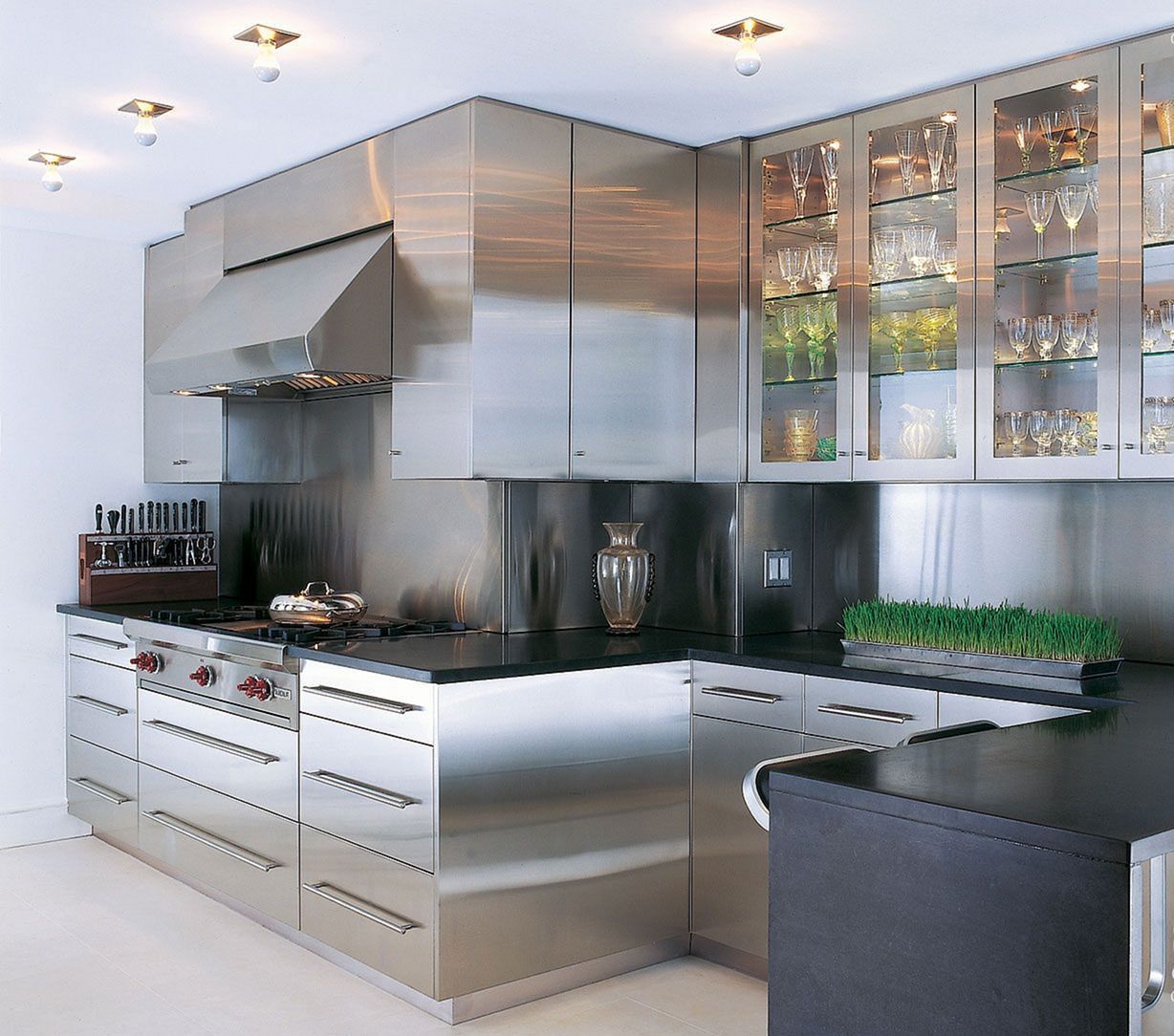Attention home enthusiasts and culinary artists! Elevate your kitchen with the sleek sophistication of metal kitchen cabinets. This comprehensive guide explores the diverse world of metal cabinetry, from material selection and design inspiration to cost considerations and maintenance tips. Discover how to create a kitchen that’s both stylish and functional with the enduring appeal of metal.
Exploring the Allure of Metal Kitchen Cabinets
Metal kitchen cabinets are experiencing a resurgence in popularity. Once primarily found in commercial kitchens, their durability, hygiene, and modern aesthetic have made them a sought-after choice for homeowners. Whether you’re aiming for a cool, industrial vibe or a sleek, minimalist look, metal cabinets offer a versatile design element for any kitchen. Let’s delve into the world of metal cabinetry and discover what makes them so appealing.
Deciding on the Right Metal: Beyond Stainless Steel
While stainless steel remains a classic for its resilience and hygienic properties, the realm of metal cabinets extends beyond this familiar choice. Different metals offer unique characteristics and design possibilities.
- Aluminum: For a contemporary, lightweight, and budget-conscious option, aluminum is an excellent choice. It presents a clean, modern aesthetic without the premium price tag.
- Galvanized Steel: To achieve an industrial chic aesthetic, galvanized steel provides a robust and visually striking option. Its durability is exceptional, adding a raw, edgy element to any kitchen. However, it requires a proper protective coating to prevent rust.
- Copper and Brass: Infuse your kitchen with luxury and warmth by opting for copper or brass cabinets. These high-end metals develop a rich patina over time, adding character and a unique touch. Keep in mind that they require more diligent care and typically come at a higher cost.
Comparing Metal Cabinet Materials: A Detailed Overview
Selecting the ideal metal for your cabinets can be a daunting task. This table simplifies the decision-making process by outlining the advantages and disadvantages of popular options, helping you find the perfect match for your style and needs.
| Metal | Pros | Cons |
|---|---|---|
| Stainless Steel | Resists rust and corrosion, modern look, hygienic, durable | Can show fingerprints, can be pricey |
| Aluminum | Lightweight, affordable, modern aesthetic, corrosion-resistant | Less durable than steel, can dent more easily |
| Galvanized Steel | Extremely durable, industrial look, unique texture | Can rust if the protective coating is damaged |
| Copper | Warm, unique aesthetic, develops a beautiful patina, antimicrobial | Expensive, requires regular polishing to prevent tarnishing |
| Brass | Luxurious, ages beautifully, adds a classic touch, antimicrobial | Expensive, can tarnish, may require specialized cleaning |
Sourcing Your Ideal Metal Cabinets
Locating the perfect metal cabinets might be easier than you anticipate. Here are some starting points for your search:
- Big Box Stores: Retailers such as Home Depot, Lowe’s, and IKEA offer a selection of ready-to-assemble and pre-fabricated metal kitchen units, often at competitive prices. This is a convenient option for budget-conscious shoppers or those seeking a quick and easy solution. metal staircases
- Specialty Manufacturers: For bespoke designs or specific requirements, consider consulting specialty manufacturers. These companies can create custom metal cabinetry tailored to your exact vision, offering unique finishes, sizes, and configurations.
- Vintage/Antique Shops: Discover one-of-a-kind treasures by exploring vintage and antique shops. You might uncover retro metal cabinets with unique character, adding a touch of history and personality to your kitchen.
Cost and Customization: Setting Expectations
The cost of metal kitchen cabinets varies significantly based on several factors. Basic base cabinets from retailers like IKEA can start around $250, while larger, custom-made units can cost upwards of $750 or more. The versatility of metal allows for extensive customization. Powder-coated colors, textured finishes, and custom dimensions can all be tailored to perfectly suit your space and design preferences.
Design Inspiration: Styling Your Metal Cabinets
Metal cabinets offer surprising versatility, complementing a wide range of kitchen styles:
- Industrial Chic: Combine metal cabinets with exposed brick, concrete countertops, and vintage lighting to create a trendy, urban loft atmosphere.
- Modern Minimalism: Pair sleek, handleless metal cabinets with clean lines, minimalist décor, and a neutral color palette for a sophisticated, contemporary look.
- Retro Revival: Embrace the charm of the 1950s and 60s with vintage metal cabinets, especially in pastel shades, to add a playful touch to a retro-inspired kitchen.
Maintenance and Cleaning: Preserving the Shine
One of the significant advantages of metal cabinets is their ease of cleaning. Regularly wiping them down with a mild detergent and avoiding harsh abrasives will maintain their pristine appearance. Avoid using steel wool or abrasive cleaners, which can scratch the surface. While stainless steel is generally resistant to rust, other metals may require specific cleaning products to prevent tarnishing or corrosion. Consistent care ensures the longevity and beauty of your metal kitchen cabinets. metal shed roofs
Are Metal Kitchen Cabinets Expensive? Weighing Cost vs. Value
Considering a kitchen upgrade and wondering if metal cabinets fit your budget? Let’s address the cost factor directly. Yes, metal kitchen cabinets can have a higher initial cost than materials like wood or laminate. However, their exceptional durability and minimal maintenance requirements can lead to long-term savings. They are likely to outlast other cabinet types, potentially saving you the expense and hassle of replacements down the line. Factors influencing cost include:
- Material Type: Stainless steel sits at the higher end, while aluminum offers a budget-friendly option. Other metals like copper or brass fall in between.
- Finish: Brushed, painted, or other custom finishes affect the overall cost.
- Customization: Unique sizes, intricate designs, and custom hardware contribute to the price.
- Installation Complexity: A straightforward installation is generally less expensive than one with custom features.
On average, metal kitchen cabinets can cost between $50 and $300 per linear foot. This is an estimate, and custom designs or intricate installations can push the price higher. High-end custom projects may exceed this range.
Here’s a table summarizing the relative costs and durability of different metals:
| Metal Type | Durability | Cost |
|---|---|---|
| Stainless Steel | Highest | Highest |
| Copper/Brass | Medium | Medium |
| Aluminum | Good | Lower |
Ongoing research into new materials and manufacturing processes suggests that more affordable options or changes in the relative costs of existing materials may emerge in the future. The market for metal kitchen cabinets is dynamic, so staying informed about these developments is beneficial.
Choosing the Best Metal for Your Kitchen Cabinets
Selecting the ideal metal for your kitchen cabinets depends on several factors, including your lifestyle, design preferences, and budget. Consider the level of activity in your kitchen. A bustling space might benefit from the resilience of stainless steel, while a quieter kitchen might allow for more design flexibility with aluminum.
Durability: Metal cabinets are renowned for their resistance to warping, spills, and daily wear, making them a sound investment. Stainless steel stands out for its resistance to rust and corrosion, while other metals offer impressive durability compared to materials like wood.
Aesthetics: Metal cabinets offer a range of stylish options. Stainless steel provides a sleek, modern, and slightly industrial feel, perfect for contemporary kitchens. Aluminum allows for greater customization with various finishes, colors, and door styles, enabling a more personalized look.
Budget: While metal cabinets may have a higher upfront cost, their longevity and low maintenance can make them a cost-effective choice over time. Stainless steel tends to be more expensive, while aluminum offers a budget-friendly alternative. Stainless steel-clad cabinets can provide the stainless steel look without the premium price.
Here’s a comparison of stainless steel and aluminum:
| Feature | Stainless Steel | Aluminum |
|---|---|---|
| Durability | Extremely high, resists corrosion | High, but can be prone to dents |
| Style | Modern, industrial | Versatile, customizable |
| Cost | Higher | Lower |
| Maintenance | Low | Low |
| Weight | Heavier | Lighter |
Ongoing research explores new alloys and coatings to enhance the performance and aesthetics of metal cabinets, including fingerprint-resistant stainless steel finishes. While stainless steel remains a popular choice, aluminum is gaining traction due to its increasing durability and style options. The future may bring even more innovative materials and designs.
Ultimately, the best metal for your kitchen depends on your specific needs and preferences. If you prioritize durability and a sleek look, stainless steel is a strong contender. If budget is a primary concern or you desire more customization, aluminum might be the better choice.
Unveiling the Hidden Drawbacks of Steel Cabinets
While steel cabinets offer a sleek and modern appeal, it’s essential to be aware of their potential downsides before making a decision.
1. Visible Wear and Tear: Steel’s smooth surface can readily show fingerprints, smudges, and minor scratches. Dents can also occur from impacts. Protective films might offer some protection but add to the cost.
2. Higher Price Point: Steel cabinets are typically more expensive than wood or laminate alternatives. This can impact your budget, potentially requiring adjustments in other areas of your kitchen renovation.
3. Noise Factor: Steel cabinets can be noisier than wooden cabinets when opening and closing, potentially disrupting a peaceful kitchen environment.
4. Cold Aesthetic: Steel’s industrial look might not suit all kitchen styles, particularly warmer, cozier aesthetics like rustic or traditional designs.
5. Fingerprint Magnet: Steel surfaces tend to attract fingerprints, requiring frequent cleaning, especially in high-traffic areas. Stainless steel finishes can help mitigate this issue but are often more expensive.
Long-Term Considerations: While these drawbacks are important to consider, they should be weighed against the benefits of steel, such as its durability and pest resistance. Ongoing research into new coatings and materials may address some of these issues in the future.
Here’s a quick summary:
| Disadvantage | Potential Solutions/Considerations |
|---|---|
| Scratches and Dents | Protective films, careful handling |
| Cost | Explore different brands, consider fewer cabinets |
| Noise | Soft-close hinges, dampening materials |
| Cold Appearance | Warm up the space with other decor elements |
| Fingerprint Visibility | Stainless steel finish (more costly), frequent cleaning |
The best choice for your kitchen depends on your individual needs, style preferences, and budget. Careful consideration of the pros and cons will guide you toward the optimal decision.
- How to Remove Water Stains from Fabric: A Complete Guide - April 26, 2025
- How to Get Motor Oil Out of Clothes: Proven Methods & Expert Tips - April 26, 2025
- How to Get Deodorant Out of Black Shirts: Easy Stain Removal Guide - April 26, 2025










